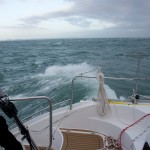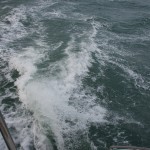Because I am writing this post, we clearly survived. Let me cover the numbers first. Max wind speed was 48.6 knots. The Beaufort scale (think Richter scale for sailors) describes a force 9 wind as “High waves whose crests sometimes roll over. Dense foam is blown along wind direction. Some branches break off trees. Construction/temporary signs and barricades blow over.” We did not see any construction signs blow over but there is a paucity of construction 10 miles off the Brazil coast. We only had 40+ knots for 6 hour stretches so the seas did not build to Mr Beaufort’s level.
Two Fish’s max speed over ground (SOG) was 19.0 knots (fast enough for a ticket in a school zone). The top speed occurred when I turned the autopilot off and hand-steered. At the top of the wave, I let the boat descend into the trough and set my personal record. There is so much buoyancy in the bows that the boat was never thinking about burying a bow.
My first take-away from two days of near gale and gale conditions was massive confidence in the boat. Inside the cockpit enclosure, it felt like 20 knots on a smaller boat. However, it is not the wind but wild seas that sailors fear. The professional skipper on our buddy boat, Live Wide, insisted that the wave heights to exceeded 5 meters, but I rated them at a more conservative 4 meters. Two Fish has a reassuring motion in these following seas. She never falls to hard into a trough and seems to lift herself gracefully over the wave sets. Before this post drifts into a marketing piece for Antares, I must discuss the noises. Monohull sailors will be shocked by the loud noises that all catamarans produce in vigorous seas. After 12 hours, I began to recognize certain sounds – the whirring noise of the bobstays parting the water as the bows head down a wave is followed by the boat slowing down as it climbs up the next wave and the random slaps that the inner sides of the hull receive from opposing-angled waves passing under the bridge deck. While under the master cabin bed working on the water maker, I watched the hull flex under the pressure of some of the waves. All were within operating tolerances, but it does take a few hours to be comfortable with the experience. Gail’s reaction to the cacophony of new sounds was to bury herself face down in bed. After 20 hours, I pried her out of bed and she did a portion of my watch.
- Ensign Stowed for strong winds
- Speed data (ignore STW)
- The beauty of an angry sea
- Wake big enough to rock and anchored boat
TECHNICAL MUMBO JUMBO
ENCLOSURE: My first thought was not to keep an enclosure up on any boat in over 30 knots. Years ago I delivered a boat from NY to Florida and we kept the enclosure on up to 50 knots; however, I spent the entire time concerned it would rip away. On the Antares in 45 knots true (37 kn apparent) there was no sign of stress. I think this is because the enclosure was part of the initial design. The enclosure was so solid it was tough to know that it was blowing hard. I was wearing my PFD (lifejacket) but with the enclosure up, this was probably overkill. Some other day I will discuss the Spinklock PFD with AIS.
SAILS: We had two different set-ups in 40+ with true wind angles of 140-165. The first time we had only a two-reef main. This would not have been my first choice, but it was very easy to handle. The full length battens kept the shape nicely and the preventer line rigged from the end of the boom to the mid-cleat created stability. This set-up would be good for breaking waves as the main is much higher than the genoa. For our second encounter, we had the genoa at 1.5 reefs. The genoa leaves you prepared for further windspeed increases, but the sail often loses shape as you sail down waves.
WEATHER HELM: The main-only set up had about 9 degrees of weather helm. This is not ideal for speed, batteries and steering gear. The helm was more neutral under genoa.
ROLLER MAIN: Our buddy boat, Live Wide, has the furling main so we had multiple chances to compare this to our slab reef main. The roller main is probably better than the tradition main when the breeze exceeds 40 knots. This is because the roller allows for easy deployment and can be furled to a smaller size than the double reefed traditional main. The two reef main on the traditional rig is about the size of the genoa. Too large for over 40. Several more experienced owners have wished that the boat had a third reef or a deeper second reef. Too early for me to weigh in on the topic.
REROUTE JIB SHEETS: We found that having the sheet led to a block forward as a barber hauler and then to a second block attached to the aft cleat was ideal for this wind condition. The barber hauler block allows for a nice sail shape and the aft block gives a sheeting angle that protects the enclosure. It is key that this block comes from the cleat as the sideways load would be too much for the toe rail. The downside of this set up is a sheet cutting across the stairs.
CHAFING: We were careful to protect the main from chaffing on the spreaders. We did observe chafe on the preventer line and main sheet blocks. The cause was using undersized line for the preventer and temporarily over-trimming the main sheet.
FOOD: Lots of Jamon y Queso on Pan. Second round we pre-thought a bit more and made some Pasta Salads to keep in the fridge. For Gail it was strictly a Quaker granola cookie diet.




5 Responses to 40+ knots of wind … How did we do?